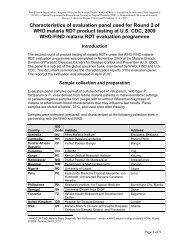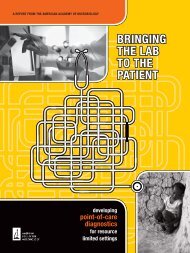Round 1 - Foundation for Innovative New Diagnostics
Round 1 - Foundation for Innovative New Diagnostics
Round 1 - Foundation for Innovative New Diagnostics
You also want an ePaper? Increase the reach of your titles
YUMPU automatically turns print PDFs into web optimized ePapers that Google loves.
clinically significant infections (e.g. young children,<br />
pregnant women, others with low immunity). The<br />
ability to detect low parasite density infections reliably<br />
there<strong>for</strong>e remains important in these cases.<br />
iii. Per<strong>for</strong>mance of tests against the challenge panel may<br />
not directly relate to sensitivity in clinical testing as<br />
there is variability in the amino acid sequence of the<br />
HRP2 antigen of P. falciparum that may affect the<br />
ability of RDTs to detect it. In certain P. falciparum<br />
parasites the HRP2 antigen may not be detectable at<br />
all. Specifically, there is evidence that P. falciparum<br />
strains in some areas of South America may express<br />
HRP2 antigens very poorly or not at all. 21 If a significant<br />
proportion of parasites in a given area do not express<br />
HRP2, it is necessary to use tests detecting other target<br />
antigens (pLDH or aldolase). The distribution of such<br />
strains is currently being mapped.<br />
iv. The methods used to transport and store tests can<br />
affect their field sensitivity. All the tests used in this<br />
evaluation were shipped and stored under conditions<br />
intended to safeguard against degradation caused by<br />
high temperature or other extreme conditions. If similar<br />
precautions are not taken with purchased RDTs, loss<br />
of per<strong>for</strong>mance could result. Ambient temperatures of<br />
storage conditions vary widely in settings where these<br />
tests are commonly used, as do temperatures during<br />
transport, and requirements <strong>for</strong> heat stability of a<br />
product will there<strong>for</strong>e differ.<br />
v. Diagnostic sensitivity and specificity are dependent<br />
on the quality of preparation and interpretation of<br />
the tests. Highly trained individuals per<strong>for</strong>med all the<br />
testing in this product evaluation. In clinical settings,<br />
malaria RDTs will often be used by health workers with<br />
limited training and supervision. Simplicity of design<br />
and clearly-interpretable results will have an influence<br />
on ensuring that the technical proficiency of a product<br />
translates into accurate diagnosis in the field.<br />
13.2. False positive rate and specificity<br />
False positive rates are reported here against a panel<br />
of 'clean' negative samples taken from blood donated<br />
in low-transmission settings by people without malaria<br />
symptoms. Also calculated were false positive rates against<br />
a smaller number of samples with specific characteristics<br />
that affect the likelihood of a false-positive result from<br />
an immuno-diagnostic test (e.g. rheumatoid factor, antinuclear<br />
antibody), or that may be of significance in a specific<br />
population (e.g. leishmaniasis, dengue). The importance of<br />
these results will vary with the intended area of use. High<br />
false positive rates against samples of blood from dengue<br />
patients, <strong>for</strong> example, may not be a significant factor to<br />
consider in regions where dengue does not occur. In view<br />
of the small number of samples in each category in this<br />
evaluation, the results should be considered primarily as a<br />
guide, to highlight potential cross-reactions that will require<br />
21 WHO 2009, unpublished data. Clarification of these findings will be<br />
made in following publications of the WHO-FIND malaria RDT evaluation<br />
programme.<br />
close monitoring if relevant to the target population.<br />
In general, it is preferable to procure a product with a<br />
low rate of false-positive reactions. In the case of many<br />
diagnostic tests, a trade-off must be made between a<br />
preference <strong>for</strong> a high rate of antigen detection (sensitivity)<br />
and a low false positive rate (specificity). The context<br />
in which the test will be used will guide the relative<br />
importance of these two factors in choosing one product<br />
over another. In this evaluation there was no correlation<br />
of loss of sensitivity associated with high specificity, with<br />
a number of products attaining both a high detection rate<br />
(predicting a high sensitivity) and a low false-positive rate<br />
(predicting a high specificity).<br />
13.3. Heat (thermal) stability<br />
RDTs in this evaluation were held <strong>for</strong> two months at 35°C<br />
and 45°C and then retested to evaluate stability at these<br />
temperatures. The importance of thermal stability will vary<br />
according to the ambient conditions under which a product<br />
is expected to be transported and stored. Thus, stability at<br />
high temperatures will be vital if an RDT is to be stored at<br />
clinic level in a country where ambient temperatures can<br />
reach 45°C in the hot season, but less critical in a highaltitude<br />
or cooler tropical environment where temperatures<br />
rarely rise above 35°C. Most of the commercial RDTs<br />
list 30°C as the maximal storage temperature. Higher<br />
temperatures were used <strong>for</strong> this evaluation because it is<br />
unusual <strong>for</strong> malaria–endemic countries to have maximum<br />
ambient temperatures less than 35°C, though the use of<br />
cool storage methods will also allow the use of less heatstable<br />
products. Where transport and storage of RDTs is<br />
likely to occur at high ambient temperatures, heat (thermal)<br />
stability should be seen as a significant factor in ensuring<br />
maintenance of sensitivity.<br />
High humidity will accelerate the degradation of malaria<br />
RDTs and other lateral flow tests. All the products in this<br />
evaluation were packaged in individual envelopes that<br />
contain a desiccant and are designed to be moisture-proof.<br />
This allows the user to open the envelope of a specific test<br />
at the time of use, limiting exposure to high humidity.<br />
During the stability testing phase of this evaluation, RDTs<br />
were stored at 75% humidity. The packaging should, if in<br />
good condition, protect the contents from exposure to<br />
high humidity during storage. As such, the stability testing<br />
results presented here provide an assessment of both the<br />
stability of the RDT and the quality of its packaging.<br />
Several products showed high stability at the temperatures<br />
and time periods used in this evaluation. In general, panspecific<br />
lines (pLDH and aldolase) were less stable than HRP2<br />
test lines, but there was overlap between the antibodies<br />
against these targets with some pLDH tests maintaining<br />
high positivity rates after 2 months at 45°C. A small number<br />
of products showed a consistent improvement in positivity<br />
rate after incubation, <strong>for</strong> reasons which are not clear.<br />
Though temperature and humidity were held constant in<br />
this evaluation, in the field temperatures fluctuate with<br />
time of day and season. While two months’ storage at a set<br />
temperature can not accurately predict long-term stability<br />
Malaria Rapid Diagnostic Test Per<strong>for</strong>mance – Results of WHO product testing of malaria RDTs: <strong>Round</strong> 1 (2008)<br />
39




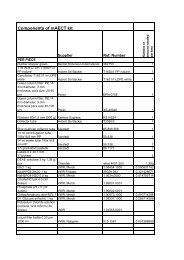
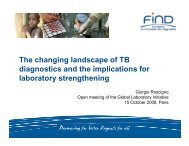
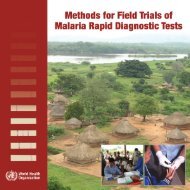
![Download in English [pdf 2Mb] - Foundation for Innovative New ...](https://img.yumpu.com/49580359/1/184x260/download-in-english-pdf-2mb-foundation-for-innovative-new-.jpg?quality=85)

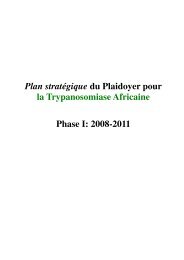
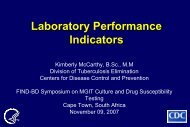
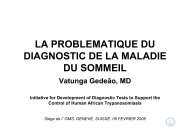
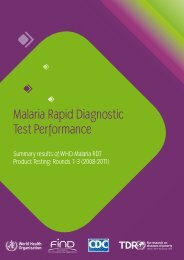
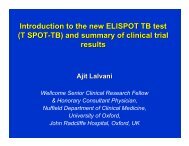
![New laboratory diagnostic tools for tuberculosis control [.pdf]](https://img.yumpu.com/43339906/1/190x135/new-laboratory-diagnostic-tools-for-tuberculosis-control-pdf.jpg?quality=85)
